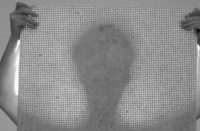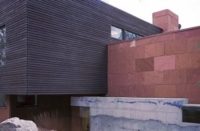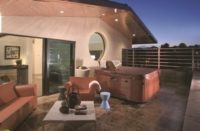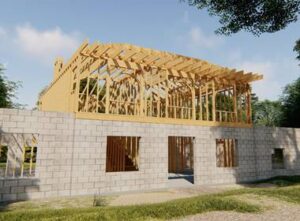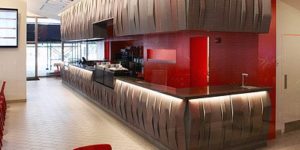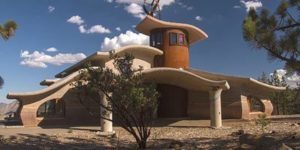
What’s old often becomes new again, and in the case of ICF (insulated concrete forms) construction, many people feel it’s not only ready for a rebirth but a healthy adolescence, as well.
The construction method first appeared in Europe after World War II, came to North America in the ’60s and then faded away in the following decade. While it’s always enjoyed a small following, those in the decorative concrete industry see it making a comeback.
They see ICFs as not only a great way to build homes, commercial structures and even decorative walls, but as offering an exterior substrate that’s just waiting for vertical concrete products.

A concrete sandwich
Builders using ICF methods already recognize the superiority of concrete. Formally described as “a system of formwork for reinforced concrete made with a rigid thermal insulation,” the process can be thought of as a concrete sandwich, with foam serving as the outside bread slices.
But we’re not talking about just any foam. The forms are interlocking modular units that are dry-stacked — often supported by rebar — then left in place to serve as insulation once the concrete is poured and cured. The most-common materials are polystyrene foam, polyurethane foam, cement-bonded wood fiber, cement-bonded polystyrene beads or cellular concrete.
Whatever the choice of modular material, they’re all pretty durable, offering better insulation against heat, cold and sound than more conventional construction methods.

They’re all pretty receptive to a wide range of coverings, too. Theo Fiorillo of Albuquerque, New Mexico, who frequently serves as a consultant on ICF construction projects, says most people utilizing the construction method don’t ask about ICF-specific finishes because ICFs can be finished the same way most other homes can be.
“They each have their own idea about what kind of house they want to live in,” he says. “And, an ICF house can be finished any way that any other house can be finished. You can put anything on it from stone and faux stone to board-and-batten to metal or vinyl siding.”
The ability of ICFs to support such a diverse selection of cladding comes from it’s flexibility. Fiorillo says he knows of one product where what he calls a “hanging stud” (also referred to as a buck or tie-in) is built into the foam product every 8 inches, specifically to support cladding.

Still another exterior assist is what Fiorillo calls a bridge ledge.
“It’s a little triangular outcropping you can use to stack brick or stone on if you want that finish,” he says. “Of course, they’re using a thin veneer — basically slices of the brick or stone.”
Another common look with these structures is stucco, which depending on the product may or may not be applied directly onto the foam.
The Sausalito, California-based ArcusStone Products is a company that manufactures natural limestone plasters which can be applied to an ICF vertical structure, either by spray or trowel, over a base coat. President Carol Kavalaris says ArcusPlaster is a cement-based limestone plaster. The company also has a lime-based product for interiors.
ArcusStone also offers ArcusStonecoat, which is composed primarily of quarried, crushed limestone and natural, integral pigments that have the appearance of natural stone when textured and finished.
The stone can be hand-carved, textured and colored to create a cut-stone look with tight or grouted joints, or even a stacked stone or dry-stack look.
Not only does ArcusStonecoat offer 5,800 psi for impact resistance, it’s also versatile enough that Kavalaris says it has found favor on horizontal surfaces, as well.
Something for everyone
ArcusStone certainly isn’t the only company offering such a product. Probably the biggest difference between manufacturers is how much prep work is required before the final coat is applied.
For instance the Picayune, Mississippi-based Flex-C-Ment offers several different concrete mixes that adhere to these polystyrene systems.
“We have thin facade materials that can be stamped out and still offer high impressive strengths,” says Gregg Hensley, vice president of marketing and sales. “We also have spray textures, micro-toppings and even a full-thickness wall mix that can be stamped to give the depiction of dry-stack or field stone. It can even be hand-carved for people who want to get custom with it.”

With any of these products, Hensley says the key to success is surface preparation, and Flex-C-Ment isn’t designed to be applied directly to any slick surface — regardless of the bonding agent. Instead, he says it’s necessary to rasp or knurl the surface. Another option is the use of a fiberglass mesh product such as SpiderLath, over which a scratch coat is applied.
Hensley says that’s particularly important if there are multiple pours of concrete within the forms due to the size or height of the project.
“If the job is done as a continuous pour, you don’t have to worry about the expansion and contraction of the ICF forms,” he says. “But, if there are cold joints within the pour, you want to have the meshing system to give you added strength for expansion and contraction.”
Jim Glessner, owner of the Sparks, Nevada-based GST International, would beg to differ. The producer of a number of coating and sealing formulations, Glessner says his company’s Elephant Armor requires nothing by way of a geotextile scratch coat or a scrub coat.
“The problem I see with ICF construction right now is the standard concrete product that is the primary product going over the foam,” he says. “A lot of these are acrylic-based mortars and they have very high failure rates. Our product can’t fail unless someone drives a tank through it.”
And, because it’s sprayed on, Glessner says the amount of square footage that can be covered in a day is head-and-shoulders above those multistep products, which may average out to only 100 to 200 square feet per person per day.
“But, like other products, you can texture it, stamp it, trowel it, roll it or put whatever finish you want on Elephant Armor,” he says.
All the advantages
Of course, texture is only one part of a wall system. Uniformly, though, these products seem to offer good color and a long lifecycle.
Emil J. Gera, owner of Emil J. Gera Concrete Contractor Inc. of Weatherly, Pennsylvania, uses Vertical Wall Mix manufactured by Kingdom Products of Throop, Pennsylvania, and he says adding color to a project is no problem.
“You can put an integral color right in the mix to give you a base color if you want,” Gera says. “Or, you can leave it the natural gray and highlight the stones to make it look like rocks.”

“Most of it is through water-based acrylic sealers and natural pigments,” he says. “You can either integrally apply the pigments to create the base color, or you can spray on a topical color that penetrates within the concrete, then come back with a second, third, even fourth color to individualize each stone. Then, you do a final seal of the product.”Flex-C-Ment’s Hensley says there are multiple ways to attack color with his company’s products.
ArcusStone’s Kavalaris agrees with the importance of sealing the project, and says that also helps with its longevity.
“It’s certainly easier to apply color as a stain afterwards, then seal it, rather than try to mix the pigments in,” she says. “Particularly in climates with a freeze-thaw cycle, it’s best to spray a penetrating sealer that’s water repellant. But, that’s true of any product.”
As for durability, Chayse Alejos, technical adviser for GST International, says if the proper steps are followed — in GST’s case, a sealer he refers to as “water brush technology” — the project should last a lifetime.
“It will never fail,” says Alejos. “It’s a permanent fix. Unless you have a 9.0 earthquake or someone drives a tractor-trailer into it, it easily has a 100-year lifecycle.”
So what’s the long-term (durable) future of ICF technology? Gera says he hopes it becomes more of an alternative to people who are looking for energy efficiency, especially as energy costs continue to rise.
Fiorillo, the consultant, agrees. He says it’s critical that people recognize the financial savings such construction represents. Also, he says, their ICF projects don’t have to look like a high school or municipal building.
“Aesthetically, it can look like any other project,” he notes about the ICF product. “That’s one of its beauties. There are no sacrifices, really, and you have the advantages, as well.”
www.arcusstone.net
www.flex-c-ment.com
www.gstinternational.com
www.geraconcrete.com
www.kingdom-products.com
